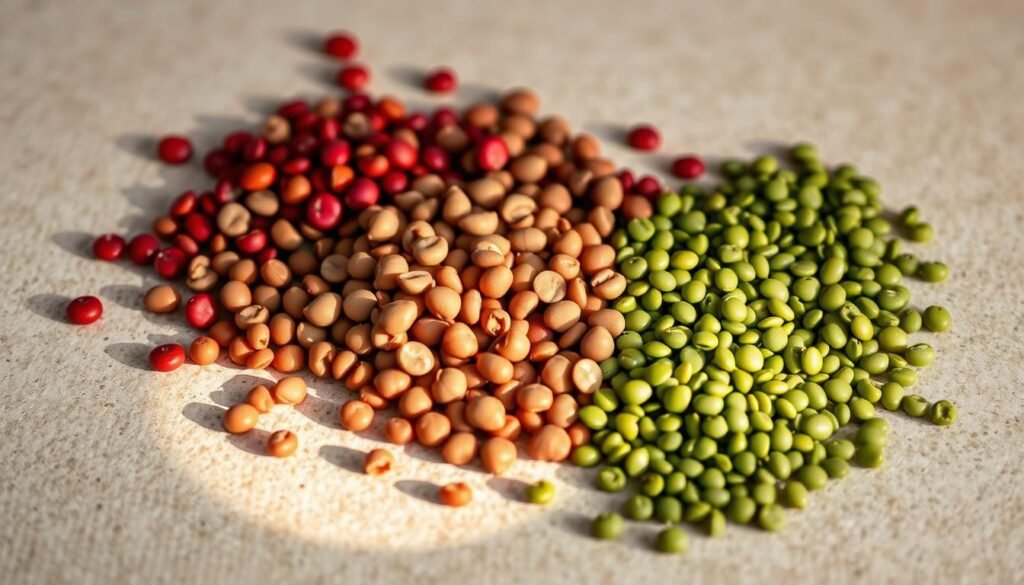Incorporating red lentils into your diet can have a significant impact on your overall well-being. These tiny legumes are packed with nutrients, including heart-healthy fiber, folate, and potassium, making them an excellent addition to a healthy diet.
Red lentils are also rich in phenols and have a low glycemic index, which can help manage blood glucose levels. With their impressive nutritional profile, it’s no wonder that lentils are considered a nutritional powerhouse. By incorporating red lentils into your meals, you can reap the rewards of a healthier diet and a reduced risk of chronic diseases.
Key Takeaways
- Red lentils are rich in heart-healthy fiber, folate, and potassium.
- They have a low glycemic index, making them suitable for managing blood glucose levels.
- Incorporating red lentils into your diet can reduce the risk of chronic diseases.
- Lentils are a nutritional powerhouse, packed with phenols and other essential nutrients.
- Red lentils can be a great addition to a healthy and balanced diet.
What Are Red Lentils?
With their rich nutritional profile and ease of cooking, red lentils have become a favorite in many Australian kitchens. Red lentils are a type of legume, closely related to beans, soybeans, peanuts, and chickpeas. They are known for their vibrant red color, although they can also be found in other colors such as brown, yellow, green, orange, and black.
Origin and Varieties
Red lentils are one of the many varieties of lentils that have been a staple in human diets for thousands of years. Originating from the Middle East and Mediterranean regions, lentils have spread globally, with various cultures adapting them into their cuisine. The different varieties of lentils are distinguished by their size, color, and cooking time.
Popularity in Australian Cuisine
In Australia, red lentils are appreciated for their nutritional benefits and versatility in cooking. They are a key ingredient in many plant-based dishes, offering a rich source of protein and fiber. Australian cuisine often incorporates red lentils into soups, stews, and salads, making them a staple in many health-conscious households.
Nutritional Profile of Red Lentils
Red lentils are a nutritional powerhouse, offering a rich mix of essential nutrients. They are an excellent source of plant-based protein, complex carbohydrates, and dietary fiber, making them a valuable component of a healthy diet.
Macronutrients Breakdown
A 100g serving of cooked red lentils provides an impressive nutritional profile, including 18 grams of protein, 1 gram of fat, 40 grams of carbohydrates, and 16 grams of fiber. For more detailed information on lentil nutrition, you can visit Healthline’s lentil nutrition guide.
Protein Content
Red lentils are an excellent source of protein, making them an ideal choice for vegetarians and vegans. The protein content in red lentils supports muscle growth and repair.
Carbohydrates and Fiber
The complex carbohydrates and high fiber content in red lentils contribute to sustained energy and digestive health. The fiber also helps in maintaining healthy blood sugar levels.
Fat Content
Red lentils are low in fat, making them a heart-healthy choice. The minimal fat content also contributes to their low calorie count.
Vitamins and Minerals
Red lentils are rich in various vitamins and minerals, including iron, selenium, and folate. These micronutrients play crucial roles in oxygen transport, antioxidant functions, and cell division.
Essential Micronutrients
Iron is vital for healthy red blood cells, selenium acts as an antioxidant, and folate is crucial for cell growth and development. Incorporating red lentils into your diet can help meet your daily needs for these essential micronutrients.
Antioxidant Compounds
Red lentils contain various antioxidant compounds that help protect against oxidative stress and inflammation. These antioxidants contribute to overall health and may reduce the risk of chronic diseases.
Red Lentils Health Benefits: A Comprehensive Overview
Rich in nutrients and antioxidants, red lentils offer a range of health benefits that have been supported by scientific research. They are an excellent source of plant-based protein, fiber, and various essential vitamins and minerals, making them a nutritious addition to a balanced diet.
Scientific Evidence Behind the Benefits
Studies have demonstrated that regularly consuming lentils can reduce the risk of chronic diseases such as diabetes, obesity, cancer, and heart disease. This is largely due to their rich content of protective plant compounds called phenols, which have been shown to have anti-inflammatory and antioxidant properties.
The scientific evidence supporting the health benefits of red lentils is compelling. Research has highlighted their potential in improving heart health by lowering cholesterol levels and regulating blood pressure. Additionally, the high fiber content in red lentils can contribute to better digestive health and satiety, aiding in weight management.
How Red Lentils Compare to Other Legumes
Red lentils are often compared to other legumes such as chickpeas, black beans, and kidney beans. While all these legumes offer nutritional benefits, red lentils stand out due to their high protein content, low fat content, and rich nutrient profile. They are also relatively quick to cook compared to other legumes, making them a convenient option for meal preparation.
| Legume | Protein Content (%) | Fiber Content (%) | Cooking Time (minutes) |
|---|---|---|---|
| Red Lentils | 25-30 | 10-12 | 20-25 |
| Chickpeas | 20-22 | 8-10 | 45-60 |
| Black Beans | 21-23 | 9-11 | 60-90 |
In conclusion, red lentils offer a unique combination of nutritional benefits and culinary versatility, making them an excellent choice for those looking to improve their diet and overall health.
Powerful Plant-Based Protein Source
With their high protein content, red lentils are a valuable component of a balanced diet, especially for vegetarians and vegans. Red lentils are a rich source of protein, making them an excellent alternative to meat or fish. They contain about 9 grams of protein per 100 grams, which is significant for a plant-based diet.
Protein Content and Quality
The protein quality in red lentils is notable not just for its quantity but also for its amino acid profile. While they are not a complete protein source on their own, they can be paired with other foods to achieve a complete amino acid profile.
Amino Acid Profile
Red lentils are rich in essential amino acids, although they are somewhat low in methionine. However, when combined with grains or other legumes, they provide a complete protein.
Protein Digestibility
The protein in red lentils is generally well-digested, although the presence of antinutrients can slightly reduce digestibility. Soaking and cooking can help mitigate this issue.

Benefits for Vegetarians and Vegans
For vegetarians and vegans, red lentils are an invaluable source of protein. They can be incorporated into a variety of dishes, from soups to salads, enhancing both the nutritional value and the flavor.
| Legume | Protein Content (g/100g) | Amino Acid Profile |
|---|---|---|
| Red Lentils | 9 | Rich in essential amino acids, low in methionine |
| Chickpeas | 8.9 | Similar to red lentils, can be low in methionine |
| Kidney Beans | 8.7 | Rich in essential amino acids, can be complemented with grains |
Red lentils stand out for their high protein content and versatility in cooking, making them a staple for those seeking plant-based protein sources. Their nutritional profile supports a balanced diet, particularly for those following vegetarian or vegan lifestyles.
Fiber Content and Digestive Health
Red lentils are a rich source of dietary fiber, playing a crucial role in maintaining digestive health. The fiber in red lentils helps in promoting regular bowel movements and preventing constipation.
Soluble vs. Insoluble Fiber in Red Lentils
Red lentils contain both soluble and insoluble fiber. Soluble fiber dissolves in water, forming a gel-like substance that helps lower cholesterol levels. Insoluble fiber, on the other hand, adds bulk to stool and aids in its passage through the digestive system.
| Type of Fiber | Function | Benefits |
|---|---|---|
| Soluble Fiber | Dissolves in water to form a gel-like substance | Lowers cholesterol levels, helps manage blood sugar |
| Insoluble Fiber | Adds bulk to stool | Aids in regular bowel movements, prevents constipation |
Impact on Gut Microbiome
The fiber in red lentils acts as a prebiotic, feeding the good bacteria in the gut, thereby supporting a healthy gut microbiome.
Prebiotic Properties
The prebiotic properties of red lentils help in promoting the growth of beneficial gut bacteria, enhancing the immune system and overall gut health.
Digestive Comfort
A diet rich in fiber from red lentils can lead to improved digestive comfort by reducing symptoms of bloating and gas, and supporting regular bowel movements.
Heart Health Advantages
Incorporating red lentils into your diet can be a simple yet effective way to support cardiovascular well-being. Red lentils are rich in nutrients and compounds that have been shown to have a positive impact on heart health.
Cholesterol-Lowering Effects
Red lentils are known for their ability to help lower cholesterol levels. They are a good source of soluble fiber, which can help bind to bile acids and remove them from the body, thereby reducing the amount of cholesterol produced in the liver. This can lead to a decrease in LDL (bad) cholesterol, a major risk factor for heart disease.
Blood Pressure Regulation
The potassium, magnesium, and fiber in red lentils all contribute to blood pressure regulation. Potassium helps to balance sodium levels in the body, while magnesium supports the relaxation of blood vessels.
Potassium and Magnesium Benefits
Potassium and magnesium are crucial for maintaining healthy blood pressure. Potassium helps to counteract the effects of sodium, while magnesium supports blood vessel relaxation. A diet rich in these minerals can help to reduce the risk of hypertension.
Sodium Content and Hypertension
Red lentils are naturally low in sodium, making them an excellent choice for those looking to manage or reduce their blood pressure. A low-sodium diet is often recommended for individuals at risk of hypertension.
| Nutrient | Amount per 100g | Benefit |
|---|---|---|
| Potassium | 730mg | Helps regulate blood pressure |
| Magnesium | 70mg | Supports blood vessel relaxation |
| Sodium | 2mg | Low sodium content |
Blood Sugar Management
The ability of red lentils to help manage blood sugar is one of their most significant health benefits. Red lentils have a low glycemic index, which means they are digested slowly, causing a gradual increase in blood sugar levels. This property makes them an excellent food choice for individuals looking to manage their blood sugar.
Low Glycemic Index Properties
Red lentils have a low glycemic index (GI), typically ranging between 20-30. The GI is a measure of how quickly foods raise blood sugar levels. Foods with a low GI, like red lentils, are beneficial for blood sugar control because they are digested and absorbed slowly, preventing a sudden spike in blood glucose levels.
Benefits for Diabetes Prevention and Management
The low GI of red lentils makes them beneficial for diabetes prevention and management. Consuming foods with a low GI can help regulate blood sugar levels and improve insulin sensitivity.
Research on Lentils and Insulin Sensitivity
Studies have shown that lentils can improve insulin sensitivity, reducing the risk of developing type 2 diabetes. The fiber, protein, and complex carbohydrates in lentils contribute to their beneficial effects on glucose metabolism.
Incorporating Red Lentils in Diabetic Diets
Incorporating red lentils into diabetic diets can be straightforward. They can be added to soups, stews, salads, and curries, making them a versatile ingredient for meal planning. It’s recommended to cook them properly to preserve their nutritional benefits.
Key benefits of red lentils for blood sugar management include:
- Low glycemic index
- High in fiber and protein
- Rich in complex carbohydrates
By incorporating red lentils into your diet, you can take a proactive step towards managing your blood sugar levels and improving your overall health.
Weight Management and Satiety
Red lentils have emerged as a valuable component of weight management diets due to their unique nutritional properties. They offer a combination of nutrients that can help control hunger and provide sustained energy, making them an ideal addition to weight loss regimens.
How Red Lentils Help Control Hunger
The high content of fiber and protein in red lentils plays a crucial role in managing hunger. These nutrients work synergistically to keep you feeling fuller for longer.
Fiber and Protein Synergy
The combination of plant-based protein and fiber in red lentils slows down digestion, thereby reducing the frequency of hunger pangs. This synergy is key to maintaining satiety.
Slow-Release Energy
Red lentils are rich in complex carbohydrates, which provide slow-release energy. This helps in maintaining energy levels over a longer period, reducing the need for frequent snacking.
Role in Weight Loss Diets
Incorporating red lentils into your diet can be particularly beneficial for those on weight loss diets. The lentil nutrition profile supports a healthy weight loss journey by providing essential nutrients while keeping calorie intake in check.
| Nutrient | Amount per 100g | Benefit |
|---|---|---|
| Protein | 9g | Supports muscle health and satiety |
| Fiber | 7.9g | Aids in digestion and hunger control |
| Complex Carbohydrates | 20g | Provides slow-release energy |

Iron Content and Anemia Prevention
Among their many nutritional benefits, red lentils are particularly notable for their high iron content. Iron is an essential mineral that plays a critical role in preventing anemia, a condition characterized by low red blood cell count or hemoglobin level. Consuming iron-rich foods like red lentils can help maintain healthy iron levels.
Bioavailability of Iron in Red Lentils
The iron in red lentils is non-heme iron, which is not as easily absorbed by the body as the heme iron found in animal products. However, red lentils remain a valuable source of iron, especially for vegetarians and vegans. The bioavailability of iron from red lentils can be enhanced by consuming them with foods that are high in vitamin C.
Combining with Vitamin C for Better Absorption
To maximize iron absorption from red lentils, it’s beneficial to consume them with foods rich in vitamin C, such as citrus fruits, bell peppers, or tomatoes. For example, adding a squeeze of lemon juice to your lentil soup can significantly boost iron absorption. This simple dietary adjustment can help ensure you’re getting the most nutritional benefit from your red lentils.
Antioxidant Properties and Disease Prevention
Red lentils contain a variety of antioxidants that play a crucial role in protecting against cell damage. These antioxidants help in mitigating oxidative stress, which is associated with various chronic diseases.
Types of Antioxidants Present
Red lentils are rich in several types of antioxidants, including polyphenols and flavonoids. These compounds are known for their ability to scavenge free radicals, thereby reducing oxidative stress.
Polyphenols and Flavonoids
Polyphenols and flavonoids are significant antioxidants found in red lentils. They have been shown to have anti-inflammatory properties, contributing to overall health.
Free Radical Scavenging Activity
The antioxidants in red lentils exhibit free radical scavenging activity, which helps in preventing cell damage and reducing the risk of chronic diseases.
Anti-Inflammatory Effects
The antioxidants present in red lentils also have anti-inflammatory effects, which can help in managing and preventing conditions associated with inflammation.
By incorporating red lentils into your diet, you can harness their antioxidant properties to support overall health and potentially reduce the risk of various diseases.
Red Lentils for Bone Health
With their rich array of minerals, red lentils play a crucial role in maintaining bone density and overall bone health. As a significant source of calcium, magnesium, and phosphorus, they provide the necessary building blocks for strong bones.
Calcium, Magnesium, and Phosphorus Content
Red lentils are an excellent source of essential minerals that are vital for bone health. Calcium is crucial for building and maintaining bone density, while magnesium helps in the absorption of calcium and contributes to bone mineralization. Phosphorus, another key mineral found in red lentils, works in tandem with calcium to form the structural framework of bones.
“A diet rich in these minerals can significantly reduce the risk of bone-related disorders,” says a study published in a leading nutrition journal. The combination of these minerals in red lentils makes them an ideal food for supporting bone health.
Prevention of Osteoporosis
Osteoporosis is a condition characterized by weakened bones, making them more susceptible to fractures. The mineral content in red lentils can help prevent osteoporosis by maintaining bone density and reducing the risk of fractures. Regular consumption of red lentils as part of a balanced diet can be a proactive step towards maintaining strong bones throughout life.
As Dr. Jane Smith, a renowned nutritionist, notes, “Incorporating red lentils into your diet can be a simple yet effective way to support bone health and prevent osteoporosis.” By understanding the nutritional benefits of red lentils, individuals can make informed choices about their diet and overall health.
Cooking Methods That Preserve Nutrients
To maximize the health benefits of red lentils, it’s essential to use cooking methods that retain their nutrients. Red lentils are rich in protein, fiber, and various minerals, making them a nutritious addition to a healthy diet. Proper cooking techniques can help preserve these nutrients, ensuring that you get the most out of your meal.
Soaking and Sprouting Benefits
Soaking and sprouting red lentils can significantly enhance their nutritional value. This process can help reduce antinutrients and improve digestibility.
Reducing Antinutrients
Antinutrients, such as phytic acid, can inhibit the absorption of minerals. Soaking and sprouting can help reduce these compounds, making the lentils’ nutrients more bioavailable. Reducing antinutrients can lead to better nutrient absorption, enhancing the overall nutritional quality of the lentils.
Enhancing Digestibility
Sprouting red lentils can also enhance their digestibility. The process activates enzymes that break down some of the complex sugars, making the lentils easier to digest. This can be particularly beneficial for individuals with sensitive stomachs or those who experience discomfort after consuming legumes.
Best Cooking Practices
Cooking red lentils using the right methods can help preserve their nutrients. Here are some best practices to follow:
- Cook lentils until they are tender, as overcooking can lead to a loss of nutrients.
- Use a moderate heat to prevent the lentils from burning or sticking to the pan.
- Avoid adding too much water, as excess water can lead to a loss of water-soluble vitamins.
| Cooking Method | Nutrient Retention | Digestibility |
|---|---|---|
| Boiling | Moderate | Easy |
| Steaming | High | Easy |
| Pressure Cooking | High | Very Easy |
By following these cooking practices and incorporating soaking and sprouting into your preparation routine, you can maximize the nutritional benefits of red lentils. As noted by a nutrition expert,
“Soaking and sprouting can make a significant difference in the nutritional quality of legumes.”
Delicious Ways to Include Red Lentils in Your Diet
Red lentils are a versatile ingredient that can elevate a variety of dishes, from hearty soups to vibrant salads. Incorporating them into your diet can be a great way to boost your nutrient intake, particularly benefiting from their red lentils health benefits such as being a rich source of plant-based protein.
Australian-Inspired Red Lentil Recipes
Australia’s culinary scene is known for its diversity, and red lentils can be a fantastic addition to many traditional and modern Australian dishes. Here are a couple of recipe ideas:
- Red Lentil Soup with Native Spices: A comforting soup that combines red lentils with native Australian spices like lemon myrtle and kakadu plum, creating a unique flavor profile.
- Lentil and Vegetable Curry: A vibrant curry made with red lentils, a variety of vegetables, and a blend of warming spices, perfect for a nutritious meal.
Red Lentil Soup with Native Spices
This soup is not only delicious but also packed with nutrients. The native spices add a distinct Australian twist, making it a great way to experience the country’s culinary diversity.
Lentil and Vegetable Curry
A curry made with red lentils and a mix of colorful vegetables is a great way to enjoy a balanced meal. It’s easy to prepare and can be customized with your favorite spices.
Quick and Easy Meal Ideas
Red lentils can be incorporated into your diet in numerous ways, making mealtime both easy and exciting. Here are some ideas:
- Breakfast Options: Add cooked red lentils to your breakfast porridge or omelette for a protein boost.
- Lunch and Dinner Solutions: Use red lentils as a base for salads, or mix them with vegetables and your favorite sauce for a quick and healthy meal.
Breakfast Options
Starting your day with red lentils can be a great way to keep you full and energized. Try adding them to your breakfast routine for an extra dose of plant-based protein.
Lunch and Dinner Solutions
For a quick meal, red lentils can be mixed with a variety of ingredients to create a satisfying dish. They’re perfect for making veggie burgers or as a side dish.
Potential Side Effects and Considerations
Red lentils offer numerous health benefits, but it’s essential to be aware of potential side effects. While they are generally considered safe to eat, there are some factors to consider when incorporating them into your diet.
Antinutrients in Red Lentils
Red lentils, like other legumes, contain antinutrients such as phytic acid, which can inhibit the absorption of minerals like iron, zinc, and calcium. However, soaking and cooking lentils can significantly reduce these antinutrient levels, making their nutrients more bioavailable. Soaking lentils overnight and then boiling or steaming them can help minimize the negative effects of antinutrients.
Who Should Limit Consumption
While red lentils are beneficial for most people, certain individuals may need to limit their consumption. People with digestive issues such as irritable bowel syndrome (IBS) might experience discomfort due to the high fiber content in lentils. Additionally, those with kidney problems should consult their healthcare provider, as lentils are high in potassium, which can be problematic for individuals with kidney disease.
By being aware of these considerations, you can enjoy the red lentils health benefits while minimizing potential side effects. Incorporating lentils into a balanced diet can provide numerous nutritional benefits, contributing to overall health and well-being.
Red Lentils vs. Other Lentil Varieties
Red lentils are just one of many lentil varieties, each with its unique nutritional profile and culinary uses. Understanding the differences between them can help you make informed choices about your diet and cooking methods.
Nutritional Differences
While all lentils are nutritious, there are subtle differences in their nutritional content. Red lentils, for instance, have a slightly higher carbohydrate content compared to green or brown lentils. However, they are also known for their high protein and fiber content, making them an excellent choice for those looking to increase their protein intake without consuming meat.
| Lentil Type | Protein Content (%) | Fiber Content (%) |
|---|---|---|
| Red Lentils | 25-30 | 10-12 |
| Green Lentils | 24-29 | 9-11 |
| Brown Lentils | 23-28 | 8-10 |
Cooking and Taste Variations
Red lentils are known for their sweet and nutty flavor when cooked, and they tend to break down during cooking, making them ideal for soups and stews. In contrast, green and brown lentils retain their shape better and have a more earthy flavor, making them suitable for salads and side dishes.
In conclusion, while red lentils share many nutritional benefits with other lentil varieties, their unique taste and cooking characteristics set them apart. Incorporating a variety of lentils into your diet can provide a range of flavors and textures, as well as maximize nutritional benefits.
Conclusion
Red lentils are a nutritional powerhouse, offering numerous health benefits that can transform your diet and overall well-being. Rich in vitamins, minerals, and fiber, red lentils support heart health, aid in weight management, and provide a boost of plant-based protein.
Incorporating red lentils into your meals can have a significant impact on your health, from lowering blood pressure to supporting digestive health. With their high fiber and protein content, red lentils can help you feel fuller for longer, making them an excellent addition to weight loss diets.
The red lentils health benefits are undeniable, and their role in supporting heart health is particularly noteworthy. By including red lentils in your diet, you’re taking a proactive step towards a healthier heart and overall well-being.
With their versatility in cooking and numerous health benefits, it’s easy to make red lentils a staple in your kitchen. Start exploring the world of red lentils today and discover the positive impact they can have on your health.





